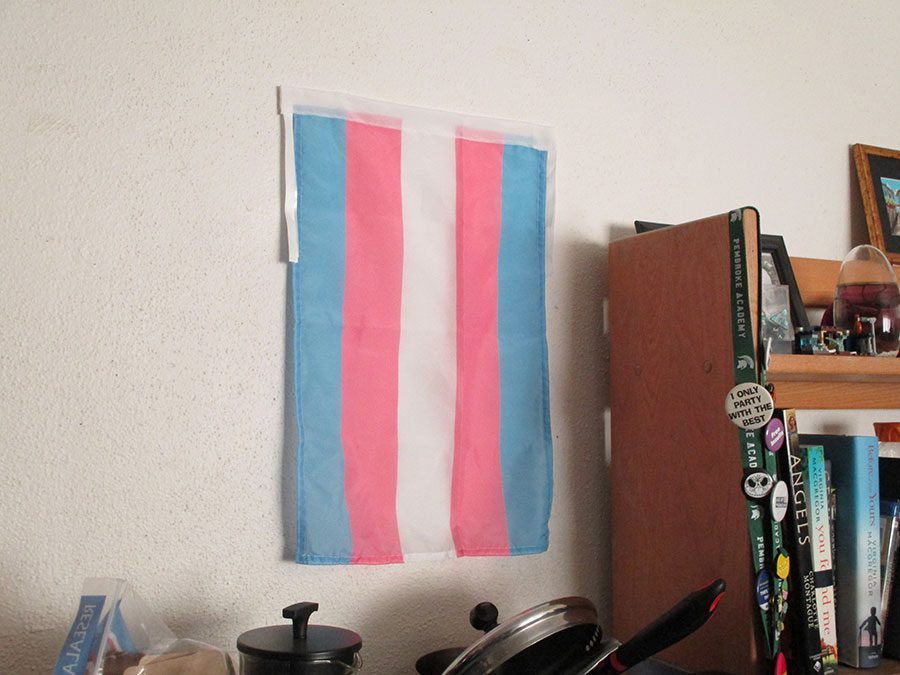Trans students speak out about frustration, discomfort at NVU-J
Editor’s Note: This is part one of a two-part series.
It’s a weekday morning, and it’s time to start the daily routine. James Teague leaves the safety of his room in Governor’s North and heads for a shower in a bathroom he unlocks with a key. Standing just so at 5’3” with his head of short, dirty-blond hair; large, rounded glasses perched on his nose; and a rounded and blushed face, he might be mistaken for a high schooler. Talk to him, though, and immediately his hyperintelligence shines through.
It’s not easy to explain the terror Teague says he feels from walking down this hallway, surrounded by the rooms and presences of other men much larger than himself. Often, he says, he’s been stopped and questioned for using the very bathroom he bathes in every day.
Teague is a transgender man. His experiences, like the ones shared by other trans students at Johnson, paint a very bleak picture about what it means to be a trans person at Northern Vermont University-Johnson.
“There’s an open room of showers here,” Teague says, motioning to the bathrooms on the first floor of Governor’s North. “Obviously, I can’t use that. This is a floor full of cis men, and I have not had top surgery. I’ve not been on hormones long enough. I have a target on my back because I don’t look the way a man looks, but I’m living in a man’s dorm. I have a high-pitched voice. Visibility isn’t great for a trans person.”
According to Teague, this isn’t a matter of imagined insecurity, either. “I have been followed down the hallway,” he says. “People have stopped outside my door and introduced my room as the room where the weird girl lives.”
Because of this harassment, Teague says he asked for an alternate place to shower. “They have a little accessibility stall that you can use,” he says. “I had to ask for the key, and it took a week to be processed. It’s a manual key on my lanyard, and sometimes it sticks in the door.
They didn’t tell the maintenance staff I was using the bathroom there, so for a while, I had to navigate around the cleaning equipment that was always left in there, and some huge machine.”
The bathroom in question is located behind the one in Governor’s North. It has the same fluorescent lights like every other bathroom on campus, but it has a shower with handles and a long-nozzled showerhead, a sink and vanity combo with a mirror, a chair, two small trash cans and a toilet, all in one room.
Standing right in the middle of the modestly-sized L-shaped room, Teague opens his arms to form a small radius around himself, filling the middle third of the room. “The machine was here, about this size,” he says.
Bathrooms are just one of the problems that plague trans students at Johnson. “Last year when people still were still not sure, [of my visual gender] I went to the girl’s room, says Jameson Lynch, a trans man who currently lives in the campus apartments. “I hadn’t had top surgery yet and I still had breasts, so I said, ‘I don’t care. I’ll use the women’s bathroom.’ Now that I have a beard and can pass as a man, I use the men’s bathroom.”
Lynch, with rounded glasses and dark, short hair, is a stocky guy with a patchy beard. His arms are dotted with tattoos and he wears a rainbow beanie nearly every day. Unlike Teague, he doesn’t attempt to hide his transness; his phone has a trans flag sticker on the back and he often posts photos of his chest as he recovers from the top surgery he had nearly six months ago.
Teague also stated that when in academic buildings without gender-neutral bathrooms, he uses men’s restrooms as well. Even with his key for the Governor’s bathroom, he has a hard time. “I don’t really have a place that I feel comfortable going to the bathroom,” says Teague.
Just across campus in Martinetti, where most trans students on campus are housed, all students living on the gender-neutral floor of the residence hall use a gender-neutral bathroom.
With this bathroom, students, regardless of their gender, can shower and go to the bathroom in private stalls. “I think that they should move students automatically into Martinetti so that we can all be in the same cluster,” says Teague. “There is nothing that beats having a community, and I don’t have a community here [in Governor’s].
Even with a trans-friendly floor in Martinetti, housing situations haven’t always been perfect there. “I transferred rooms my first semester because my roommate and I didn’t get along,” says Lynch, who lived in Martinetti at the time. “Res Life just sorta put me with the other trans person that needed a roommate.”
“When I reached out and said, ‘I’m having issues and I need my own room,’ they waited until a room in Martinetti opened up. The person I was placed with, we were both trans, but we were different genders that way, and we had both been hoping to be placed with people of our same gender. Instead, we were complete opposites. I feel like they didn’t look at the roommate papers we filled out. I felt like they said, ‘Oh, this is a trans person, and this is a trans person. Let’s put these people together.’
“People who had emailed afterward had been moved to completely different buildings,” he says. “I knew there were rooms that I just wasn’t getting, both on men’s floors and women’s floors. I told Res Life I didn’t care what floor they put me on, honestly. I just needed to be in my own space. I didn’t have any issues using either bathroom.”
Deadnaming, or being called by an outdated name, is another issue that trans students face here on campus, both in the official and unofficial record.
“The only reason I have the right [preferred] name on my ID tag is that my dad tricked them,” says Teague. “He marched me into the office during the tour and was like, ‘This is James Teague, take a photo!’ When I got to campus, they still had me down as my deadname and they gave me a temp card because I hadn’t ‘gotten my picture taken.’ But I did have it.”
Teague’s ID currently has his preferred name. However, he says, “I don’t have my name in correctly anywhere else on this campus.”
Lynch had much the same. “I was misgendered a lot at first,” he says. “I didn’t really want to confront the teachers, because a lot of the professors are older. There was actually a different professor that confronted the professors and explained it to them. It was nice, but I didn’t want to have that confrontation.”
With all the negatives that come with being trans at Johnson, Lynch still feels positive about it.
“It’s nice here because people are really accepting,” he says. “I lived in the south for a while. It’s great here, but there are still spots I’m still uncomfortable.”
Teague has less positive things to say about the culture and attitude of students and faculty regarding trans people. “It’s not good,” he says. “I wouldn’t even say it’s okay. For the most part, a lot of the teachers and the staff are fine. There have been a few off comments, but that’s expected. But the student body hates us. I have not had a pleasant interaction with another student about being transgender unless that student was also trans.”
Plus, he adds, it’s less about things being stellar and more about them being just passable. “I didn’t really have to fight with res life to get my room,” he says. “It just took a while. I had to be patient about a lot of it, which is really hard because I didn’t want to keep waiting for things. A lot of people don’t know how to react or how to help. I’m either telling them how to help or letting them figure it out on their own.”
Lynch summarizes the lukewarm friendliness and mild hostility with the way he comes out to new people: “I’m never really hiding it, I’m just not like, ‘Hello my name is James. I am trans.’ I’m gonna let you figure it out by yourself. It’s a partial fear of me coming out and you reacting badly, and partially I want to see how smart people are. If I’m obvious about it, I want to see how long it takes people to notice.”
When asked about his mostly-positive experience versus so many others’ negative ones, Lynch said, “My experience differs from a lot of people. I didn’t really come out here at Johnson. I just let people question until they asked me. A lot of people kinda figured it out by themselves. I do wear a rainbow beanie almost every day and have a trans sticker on my phone.”
Part of the frustration comes with a disconnect between trans students and administrators. Both Lynch and Teague expressed frustration at the lack of administrative support for trans issues. “Here, there’s no community for me,” said Teague. “It’s openly hostile. We have a gay flag up, but it’s so performative it makes me sick.”
While there are no department-specific formal policies that mention trans students other than the non-discrimination policy known as 311, which can be found at resolve.vsc.edu, the State of Vermont released a document called “Continuing Best Practices for Schools Regarding Transgender and Gender Nonconforming Students.”
According to this document, “It is the policy of the State of Vermont that all Vermont educational institutions provide safe, orderly, civil, and positive learning environments.”
But even if formal policies do get written, Teague says, things won’t change. “For the most part, I don’t think the administration can do much to change the environment here,” says Teague, “because it’s not the administration, it’s the students.”
Several other trans and nonbinary students were contacted for interviews, but declined due to their concerns about safety. Other students’ experiences will appear in Part Two of this series.

Senior, Journalism & Creative Writing
Grew up in Atkinson, NH
Fall 2018
Along with traditional journalism, I enjoy writing satire and fun feature...



